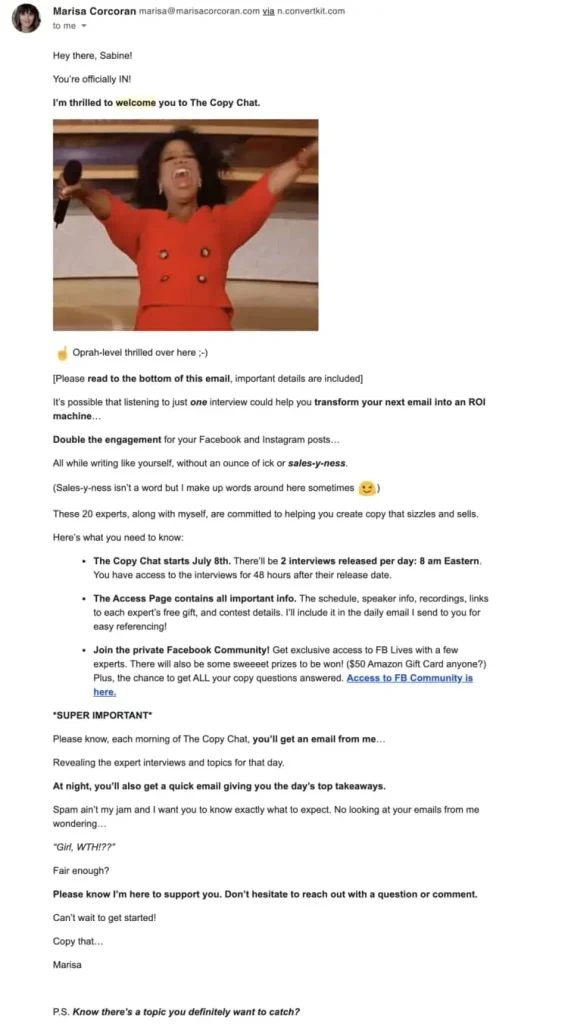Creating Welcome Emails that Engage Subscribers for the Long Term: The Definitive Guide
Written by:
You probably know about the power of email marketing to boost your sales, inspire people to take action, and build relationships. And yet, many businesses send Welcome emails that say little more than “thanks for signing up — please whitelist our email address”. With Welcome emails getting 86% higher open rates than other newsletter emails, that’s a tragic loss of a brilliant opportunity to leave a strong first impression and engage readers from the get-go. So in this definitive guide, we’ve assembled 39 tips and techniques that will help you make your Thank-You email count. Some are quick wins. Others take a bit more thought. And others are a matter of taste — both your own and that of your audience. But they’re all here. Bonus: nailed your Welcome email but not sure what to write next? Download our free checklist with 30 creative newsletter ideas here.
Write a Subject Line that Makes Readers Want to Open Your Welcome Email
1. Just writing “Welcome to XYZ” isn’t enough.
Make your subject line more inviting by giving meaning to their subscription. Sian Conway does this beautifully with her Welcome email at Ethical Hour:

2. Your subject line should stand out and be different from what other people send in the same situation:
- Make it either shorter or longer than the majority of subject lines. This will help attract attention and therefore, clicks.
- Not every Welcome email has to say “Welcome” or “Thank You”.
- Try adding appropriate emojis to your subject lines — they can make your email pop!
- Test special characters such as ampersands (&), percentages, dashes, etc. They all stand out amongst purely word-based emails.
- Include your reader’s name in the subject line for an extra personal effect.
- Don’t tell the whole story in your subject line. Make people curious!
- The subject line has one job: to get people to open the email. Once that’s done, the subject line has done everything it needed to do.
3. Consider following the 4U practice and making your subject line…
- Ultra-specific
- Urgent (but steer clear of fake urgency!)
- Useful
- Unique
4. If people signed up for a freebie (aka lead magnet), consider mentioning it in your subject line.
This will boost your open rates and demonstrate that you’re the kind of business that keeps its promises. (If you’re in B2B, check out Andrew Yedlin’s in-depth guide to writing a nurture sequence on Conversion XL.) Never bury your freebie at the end of the email:
- Decide how many different lead magnets people can sign up for.
- Match your welcome emails perfectly to those lead magnets.
- Introduce the relevant freebie and what people can do with it. Build their excitement about using it.
- Then talk about who you are, what you do, and what’s going to come next.
- You’ll create a journey that feels completely linked up. Everything that you’re going to send your readers in the future has already been foreshadowed in a natural, easy, flowing way.
5. Match your subject line to the message of your sign-up form.
If you’re inviting people to be part of the change you’re creating, reaffirm that change in your subject line.
6. Put yourself into the shoes of your subscribers.
A lot of people offer tricks and “magical secrets” to writing “the right” subject lines. None of that’s really necessary though.
- What will they find interesting?
- How can you signal value to them?
- How can you add depth and meaning to their sign-up?
- Write down at least 10 subject line ideas and pick your favourite.
- Play around with the subject line until you’ve got the open rate you’re striving for.
Don’t Miss the Importance of Your Sender Information
7. Don’t just state your company in the sender information.
If you can, let someone on your team own these emails and add their name too.
The trust your readers feel when they read this info is the single biggest factor affecting your open rates.
8. Display your name according to the cultural expectations of your customers.
For example, in a more formal culture, including your last name might be a wise decision.
9.If you decide to use your name only,
make sure to include your company name in your subject line or the email preview text
Jake Crump at Product Hunt does this, too. It helps people to recall the context of your email.

Set the Tone of Your Relationship with New Subscribers
10. Thank subscribers personally for signing up.
If your signup form asks for their first name, use it. That way, your gratitude feels more genuine and a little less cut and paste.
11. Take things a step further:
Celebrate with your new reader, or congratulate them for the step they’ve taken. Show them the bigger scheme of things and remind them of the purpose you’re striving for, together. (Check out this podcast with Ry Schwartz for more on how this works.)
12. Send a clean email without any fancy design.
It really helps to emphasise your personal relationship to your reader.
For example, look at Marisa Corcoran’s Welcome email at Copy Chat:

13. Determine your verbal identity, tone of voice or house style.
Stick to it when writing your sign-up form as well as your emails. For example, if you ask people to sign up to be part of your community, then don’t bait and switch by talking about your newsletter in the Welcome email.
The difference between a community and a list of subscribers
A list of subscribers is a group of people with one thing in common: their connection with the brand.In contrast, building a tribe or a community means enabling a relationship that is more or less horizontal. A community doesn’t need the brand as a go-between. They can be in touch with each other, they communicate with each other. Yes, the brand may provide the framework, the founder may create something like a Facebook group, or a pop-up event, or a Slack channel. But once that infrastructure exists, people experience community with each other and not just with the brand.
Building a branded community
If you’ve been toying with the idea of building that kind of community, and you haven’t yet fully decided on how to make it happen, then maybe you just need to be a bit clearer about the fact that you are still in the process of building this.To whet people’s appetites, mention the benefits that you’re planning for — for example, being able to swap ideas and tips on how to reduce plastic waste, or recycling tips, or whatever else you want to connect to your theme.On the other hand, if you don’t actually want to put effort into building a new community, then maybe it’s better to pare it back and just talk about the newsletter.
14. Make your new subscriber feel good about their choice.
For example, Coromandel Coast welcomes readers to their “growing” tribe. This tells the reader that Coromandel Coast is a successful brand and that they’re part of a growing movement.
The Art of Introducing Yourself: Even When It’s About You, It’s Really About Them
15. Insert photos to the right of your email copy so they don’t interrupt reading flow.
16. Balance “I” with “you”.
It’s tempting to start every sentence in a personal introduction with “I”. But your readers will want to know what’s in it for them, now that they’ve subscribed. Rephrase at least half of those sentences so they say “you” instead of “I”. This turns the information you want to share about yourself around — so your reader understands how it benefits them.
17. If you use a picture, tell its story:
- Who’s in that picture?
- Why are you showing them this picture?
- What’s the relationship between the picture and your business?
- What is this person doing, and why does that matter?
18. Always add captions.
(Did you know that captions are some of the most-read bits of copy?)
19. Tell your impact story several times at different levels of detail.
For example, offer a quick summary in your very first email, then link to a blog post with more information. Or write a gripping story for your nurture sequence.
Future-Pace the Power of Your Emails to Improve Their Lives
20. Build anticipation and excitement from the get-go:
Tell readers about the useful content to expect in future emails.
21. You could even offer a transparent email roadmap!
That’s what Ethical Brand Marketing does. It makes your Welcome sequence feel a bit more like a course, where each email helps the reader move forward in a specific way.It’s a pattern often used by tech startups to introduce new trial users to the functionality of the platform.But any business that thinks deeply about the needs of their customers can benefit from this approach — no matter the industry.
22. Follow the Rule of One:
Each email should stick to one big idea, one promise and one offer for one reader (or group of readers). This helps you avoid confusion and drop-offs from jumping too much between different topics.
23. If you run a social enterprise, remember to empathise with your customers…
… and not just with your beneficiaries. How is your subscriber’s life going to be better if they support your work? Getting clear on this question will help set up the sale. Making an offer will feel less pushy, and the call to action will appear like the logical next step.
Get to Know Your Reader and Make Things Personal
24. Your welcome email exists to make your reader enthusiastic about 3 things:
- The newsletter subscription itself
- Downloading & using the lead magnet
- Most importantly: the relationship that you’re now going to build with the new subscriber!
25. Think about what information would help you serve your readers better, and how best to ask for it.
For example, you can personalise your salutations if you know people’s first names — a detail best included in your sign-up form. On the other hand, if you want to know which books people are currently reading, that question is more easily asked via email (because you’ll get lots of free text replies).
26. Train your new readers to take action
(and train yourself to ask them to do something!) at the end of each email by including a button, an open-ended question or a link to more information.
27. If your newsletter list is small, getting replies is the true measure of success.
Ask your readers to tell you about their lives, their work or a challenge they’re struggling with.
28. To increase response rates, make your call to action explicit.
For example: “What’s your vision for the better world you’re trying to create? Hit reply and let me know.” Or give them a sentence starter and say, ‘Tell me what your Big Why looks like. Hit reply and let me know: “My vision for the better world I’m trying to create is…”’This reduces the perceived effort of answering the question, and they’re more likely to take action.
29. Include links to content that will be useful for different types of readers.
You’ll be able to tag them according to what they clicked and send them more relevant emails in future. Segmentation has also been shown to increase open rates by up to 14.3% and click-through rates by up to 54%.
30. When including a link, always tell them:
- What can they do on these pages?
- What is the next step they can take from there to improve something in their own world?
- What’s the immediate takeaway and value for the reader?
